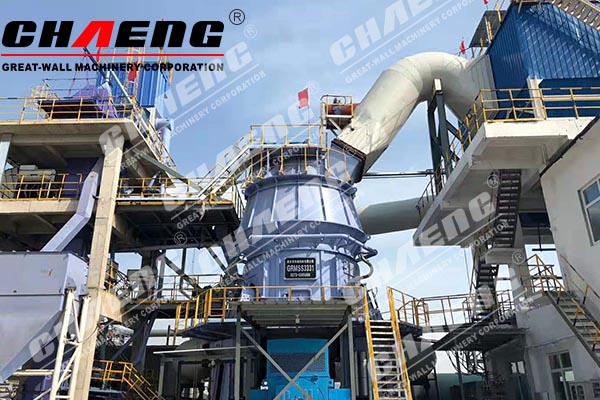
News Date:2019-10-15 14:18:58

Steel slag aggregates are highly angular in shape and have rough surface texture. They have high bulk specific gravity and moderate water absorption (less than 3 percent).
The chemical composition of slag is usually expressed in terms of simple oxides calculated from elemental analysis determined by x-ray fluorescence. Table lists the range of compounds present in steel slag from a typical base oxygen furnace. Virtually all steel slags fall within these chemical ranges but not all steel slags are suitable as aggregates. Of more importance is the mineralogical form of the slag, which is highly dependent on the rate of slag cooling in the steel-making process.
|
Constituent |
Composition (%) |
|
CaO |
40 - 52 |
|
SiO2 |
10 - 19 |
|
FeO |
10 - 40 |
|
MnO |
5 - 8 |
|
MgO |
5 - 10 |
|
Al2O3 |
1 - 3 |
|
P2O5 |
0.5 - 1 |
|
S |
< 0.1 |
|
Metallic Fe |
0.5 - 10 |
The cooling rate of steel slag is sufficiently low so that crystalline compounds are generally formed. The predominant compounds are dicalcium silicate, tricalcium silicate, dicalcium ferrite, merwinite, calcium aluminate, calcium-magnesium iron oxide, and some free lime and free magnesia (periclase). The relative proportions of these compounds depend on the steel-making practice and the steel slag cooling rate.
Free calcium and magnesium oxides are not completely consumed in the steel slag, and there is general agreement in the technical literature that the hydration of unslaked lime and magnesia in contact with moisture is largely responsible for the expansive nature of most steel slags.(1,2) The free lime hydrates rapidly and can cause large volume changes over a relatively short period of time (weeks), while magnesia hydrates much more slowly and contributes to long-term expansion that may take years to develop.
Steel slag is mildly alkaline, with a solution pH generally in the range of 8 to 10. However, the pH of leachate from steel slag can exceed 11, a level that can be corrosive to aluminum or galvanized steel pipes placed in direct contact with the slag.
Tufalike precipitates, resulting from the exposure of steel slag aggregates to both water and the atmosphere, have been reported in the literature. Tufa is a white, powdery precipitate that consists primarily of calcium carbonate (CaCO3). It occurs in nature and is usually found in water bodies. The tufa precipitates associated with steel slags are attributed to the leachate combining with atmospheric carbon dioxide. The free lime in steel slags can combine with water to produce calcium hydroxide (Ca(OH2)) solution. Upon exposure to atmospheric carbon dioxide, calcite (CaCO3) is precipitated in the form of surficial tufa and powdery sediment in surface water.
|
Property |
Value |
|
Los Angeles Abrasion (ASTM C131), % |
20 - 25 |
|
Sodium Sulfate Soundness Loss (ASTM C88), % |
<12 |
|
Angle of Internal Friction |
40° - 50° |
|
Hardness (measured by Moh's scale of mineral hardness)* |
6 - 7 |
|
California Bearing Ratio (CBR), % top size 19 mm (3/4 inch)** |
up to 300 |
|
Hardness of dolomite measured on same scale is 3 to 4. |
|
Processed steel slag has favorable mechanical properties for aggregate use, including good abrasion resistance, good soundness characteristics, and high bearing strength. Table lists some typical mechanical properties of steel slag.
Due to their high heat capacity, steel slag aggregates have been observed to retain heat considerably longer than conventional natural aggregates. The heat retention characteristics of steel slag aggregates can be advantageous in hot mix asphalt repair work in cold weather.
1. One set of system is enough, low operating costs
When the specific surface area of the products reaches 4500cm²/g, the average grinding capacity of the CHAENG’s steel slag vertical mill can reach 90t/h. But choosing ball mill, there are at least six sets of ball mill systems being required.
2. The power consumption of vertical mill system is 20% lower than ball mill
For many cement enterprises, the high energy consumption of ball mill system is such a big headache. But the new type of vertical mill is a kind of energy-saving and environment-friendly grinding equipment. Compared with ball mill system, vertical mill can save 30%-50% power. Also compared with traditional vertical mill, CHAENG’s steel slag vertical mill has large external circulation ratio, which can reduce the system power consumption by about 20%.
3. Low dust pollution
The ball mill requires several auxiliary equipment and conveyors due to the complicated system process, which will cause serious dust pollution. The steel slag vertical mill system is fully enclosed integrating functions of conveying, grinding, drying and powder separating and CHAENG also installs dust collectors in the vibrating screen frame and the feeding frame, which really achieves the “low” emission of dust.
4. High iron separation rate, improving economic efficiency
Steel slag generally has an iron content ranging from 1% to 3%. CHAENG optimizes the iron separation process of the vertical mill grinding system, and adds several iron removers to the feeding system, which greatly increases the iron removal amount and improves the integrated economic and environmental benefits.
5. Advanced slag discharge belt, to reduce the wear of grinding roller
The slag discharge belt adopts the advanced flat belt and paving device, which enables the iron remover suspended on the belt to more effectively magnetically select the iron-containing material discharged from the mill to prevent it from being re-grinding, so as to reduce the wear of the grinding roller.
6. Finished fineness can be guaranteed at 480-500m2/kg